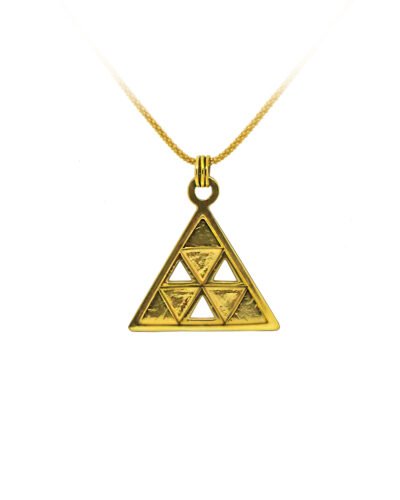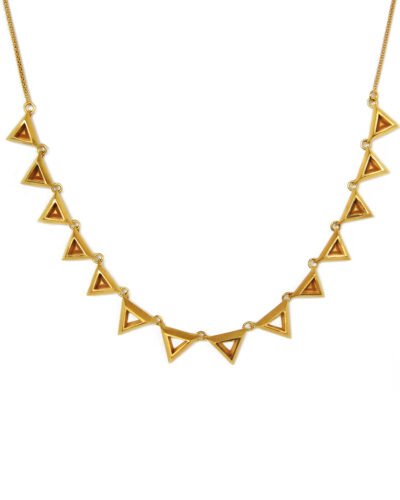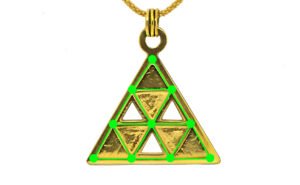
You can read the first part of the Symbolism & Magic of the Triangle here

Tetractys
The Tetractys is a figure made up of ten points arranged in four rows, with one point in the first row, two in the second, three in the third, and four in the fourth.
In Ancient Greece, the Tetractys was seen as a symbol of the divine and was associated with the Pythagorean philosophy. The first row represented the Monad, the divine source of all things, while the second row symbolized the Dyad, which represented the contrast and duality of the universe. The third row represented the Triad, which represented harmony and balance, and the fourth row represented the Tetrad, which symbolized the four elements (earth, air, fire, and water) and the four seasons.
The Tetractys was also used as a symbol of the mystical and spiritual in various mystery schools and secret societies. In these groups, the Tetractys was seen as a symbol of creation and the power of the divine in the universe. It was also seen as a symbol of the human soul’s journey towards enlightenment.
In the Pythagorean tradition, the Tetractys was also used as a symbol of the musical harmony of the universe. In this case each row was associated with a musical interval.
In some spiritual traditions, the Tetractys has also been associated with the elements of nature (fire, air, water, earth) and the four directions (east, north, west, south).
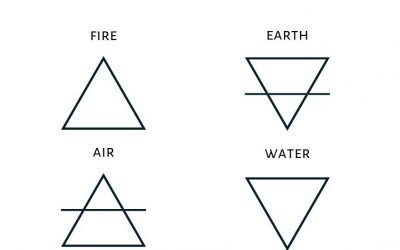
Four element symbols of Alchemy
Alchemy is an ancient and esoteric practice that seeks to transform base metals into gold and find the elixir of eternal life. Alchemists believed that everything in the universe was made up of a combination of the four classical elements: fire, air, water, and earth. Each of these elements was associated with specific qualities and properties.
Fire: Upward-pointing triangle. It was associated with the transformative and purifying power of heat and was believed to represent the spirit. It was also associated with passion, creativity, and the force of will.
Air: Upward-pointing triangle with a horizontal line through the center. It was associated with the power of breath and was believed to represent the intellect or mind. Air was also associated with communication, clarity, and the power of thought.
Water: Downward-pointing triangle. It was associated with the power of flow and movement and was believed to represent the emotions and the subconscious. Water was also associated with purification, cleansing, and the power of intuition.
Earth: Downward-pointing triangle with a horizontal line through the center. It was associated with the power of stability and grounding and was believed to represent the physical body and material world. Earth was also associated with fertility, growth, and the power of manifestation.
Alchemists believed that by understanding and manipulating the properties of these elements, they could unlock the secrets of the universe and achieve the transformation of base matter into gold and the elixir of eternal life. They believed that these symbols represented the spiritual and material forces at work in the universe and could be harnessed and combined to create powerful and transformative effects.
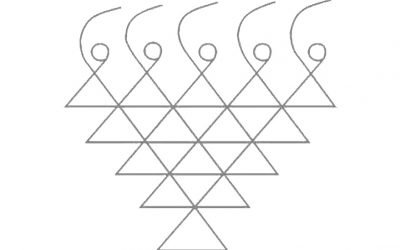
Saraswati Yantra
Saraswati Yantra is a powerful symbol in Hinduism that is associated with Saraswati, the goddess of knowledge, learning, music, and the arts. The Yantra is a sacred geometrical design that is used for meditation, contemplation, and spiritual practices, and it is believed to represent the divine energy of the goddess Saraswati.
The symbol consists of a series of triangles that symbolise aspects of the divine feminine: creation, preservation and destruction.
The Saraswati Yantra is believed to have many benefits for those who use it for meditation and spiritual practices. It is said to enhance creativity, wisdom, and knowledge, and it can help to improve communication skills, memory, and concentration. It is also believed to provide protection from negative energies and promote spiritual growth and enlightenment.

The Eye of Providence
The Eye of Providence, (aka all-seeing eye) is a symbol that is often associated with God, divine providence, and spiritual illumination. It is depicted as an eye enclosed in a triangle and surrounded by rays of light.
All-seeing eye is commonly seen in religious and spiritual contexts, as well as in art, architecture, and popular culture.
The Eye of Providence is most commonly associated with Christianity and Freemasonry.
In Christianity, the symbol is often used to represent God’s watchful and protective gaze over humanity. It is also associated with the Holy Trinity, where the eye represents God the Father, rays of light – the Holy Spirit, triangle – Jesus Christ.
In Freemasonry, the Eye of Providence is used as a symbol of the divine presence, and the obligation to be ever watchful of the actions and behaviour. It is often depicted above a pyramid, which represents the building of a perfect society and the attainment of spiritual enlightenment.
This symbol has also been used in popular culture, appearing in movies, TV shows, and even on the US one-dollar bill. In these contexts, the symbol is often associated with conspiracy theories and secret societies, which has led to its use in many fictional works.
Related Products
-
Pintadera silver
169,00€ -
Pintadera gold
175,00€ -
Delta Gold necklace
355,00€
Recent Posts
OUR NEWSLETTER
Subscribe to our newsletter and get 10% off your next purchase!


